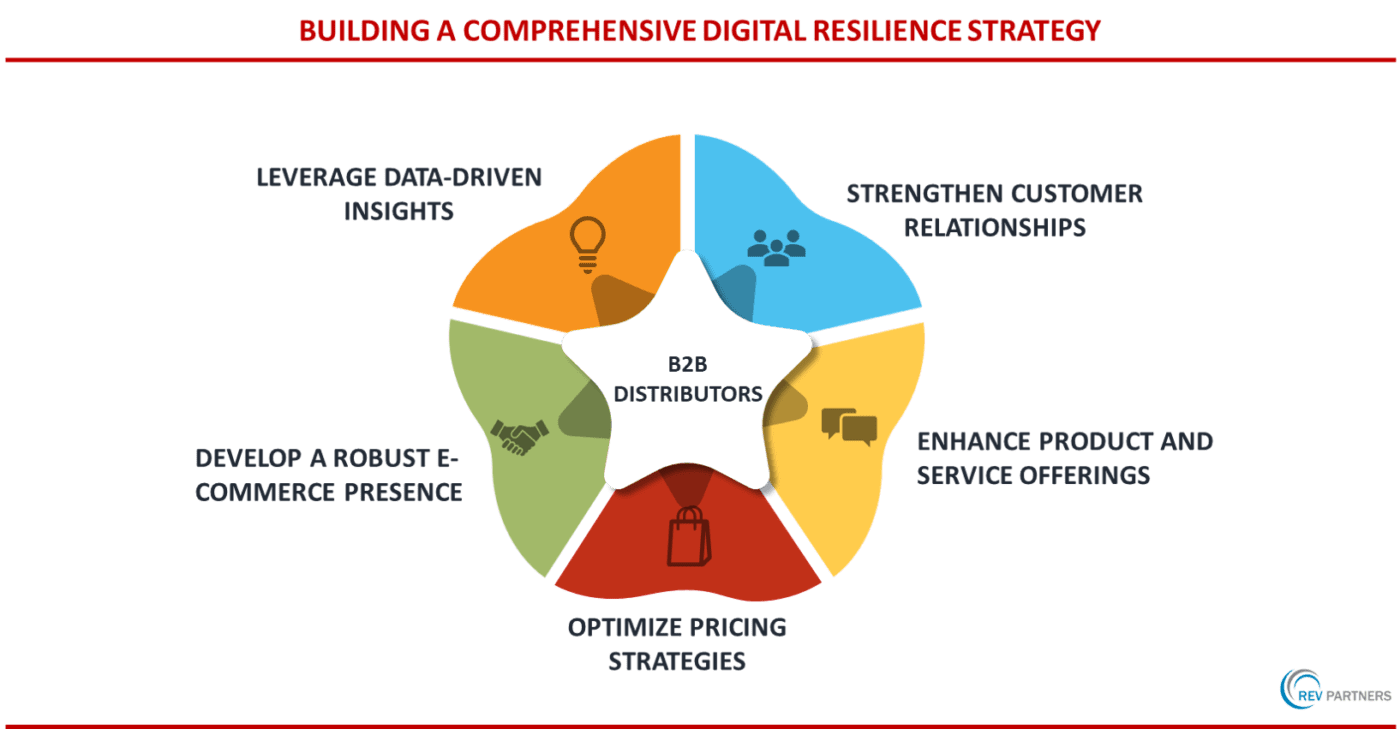The Growing Relevance of E-Commerce in B2B Markets
B2B Distributors realize that the increasing global adoption of e-commerce in B2B markets has led to greater reliance on the internet throughout the customer buying journey. The COVID-19 pandemic has only accelerated this shift, as digital transactions offer convenience and safety during periods of social distancing and lockdowns. Consequently, digital giants like Amazon, Alibaba, eBay, and Wayfair are intensifying their efforts to penetrate the B2B market, leveraging their B2C expertise and data-driven processes to engage customers and boost sales.
Embracing Digital Transformation in B2B Distribution
As the digital landscape evolves, B2B distributors must adapt to the increasing prevalence of e-commerce in their industry. This involves recognizing the advantages of digital transactions, understanding the tactics employed by e-commerce giants, and developing a strategic plan to maintain their competitive edge in the face of digital disruption.
“This involves recognizing the advantages of digital transactions, understanding the tactics employed by e-commerce giants, and developing a strategic plan to maintain their competitive edge in the face of digital disruption.”
The Amazon Effect and the Need for a Resilient Strategy
Although brick-and-mortar players continue to dominate the B2B market, they are becoming increasingly aware of the potential risks posed by digital disruptors. To maintain a competitive edge, B2B distributors must develop a strategic approach to assess the impact, threats, and opportunities of e-commerce in their industry. This involves understanding the business models, strengths, and weaknesses of digital players, identifying their company’s exposure, and developing a resilience strategy.
Understanding Digital Attackers
There are two primary types of online distributors entering B2B markets: established B2C players like Amazon, Alibaba, eBay, and Wayfair, and local, specialized startups targeting specific B2B segments. The main challenge for traditional B2B distributors comes from international e-commerce players with extensive financial and operational resources. By examining their success in B2C markets, incumbents can gain insights into how these digital giants may approach B2B markets.
To develop a successful resilience strategy, B2B distributors must first analyze the business models, strengths, and weaknesses of digital competitors. This includes examining the tactics used by established B2C players and specialized startups targeting niche B2B markets. By understanding how these digital attackers operate, B2B distributors can anticipate their moves and develop strategies to counteract them.
Identifying Vulnerabilities and Opportunities
Assessing the company’s exposure to digital disruption is crucial for B2B distributors. This involves considering various factors such as product complexity, logistical challenges, and price competitiveness, among others. By identifying their company’s strengths and weaknesses in these areas, B2B distributors can develop targeted strategies to minimize vulnerabilities and capitalize on opportunities.
B2B distributors should evaluate their vulnerability to digital disruption. Understanding the extent to which these factors shield a distributor’s sales can help them quantify their individual risk exposure.
Building a Comprehensive Digital Resilience Strategy
To thrive in the age of e-commerce, firms should adopt a comprehensive digital resilience strategy. This strategy should include the following elements:


Strengthen customer relationships
B2B distributors must prioritize nurturing strong, long-term relationships with key accounts to maintain customer loyalty in the face of digital competition. Demonstrate proximity to customers and increase penetration in key accounts through strategic and tactical moves.
Enhance product and service offerings
By offering unique value-added services and products, B2B distributors can differentiate themselves from digital competitors and create a compelling value proposition for customers. Improve customer stickiness by enhancing offerings in ways that digital attackers cannot replicate.
Optimize pricing strategies
Competitive pricing can help B2B distributors retain customers and mitigate the impact of increased price transparency brought on by digital competitors. Price competitively to mitigate the impact of increased price transparency brought by digital players and offer competitive pricing to attract customers.
Develop a robust e-commerce presence
B2B distributors must enhance their online platforms to offer a seamless, convenient customer experience that rivals that of large e-commerce players. Enhance the customer experience and compete directly online.
Leverage data-driven insights
By harnessing data and analytics, B2B distributors can make informed decisions, optimize operations, and improve overall business performance.
By adopting these strategies, B2B distributors can not only survive but also thrive in the rapidly evolving e-commerce landscape
——————————————————————————————————————————-
ABOUT REV PARTNERS
REV Partners. Business Transformation Experts. Digital Transformation Experts. We are a Management Consulting & Advisory firm. We help Fortune 500 & Private Equity clients address the most pressing issues related to Transformation, Strategy, Operations, Organization and Digital. We can also provide experienced experts as Interim “Chief Transformation Officer” or equivalent, to accelerate, lead and execute ambitious Business Transformation or Digital Transformation programs. If you or your organization need support, please contact us, follow us on Twitter, or Email us at: meet@revpartners.com.
© REV Partners. All Rights Reserved.

